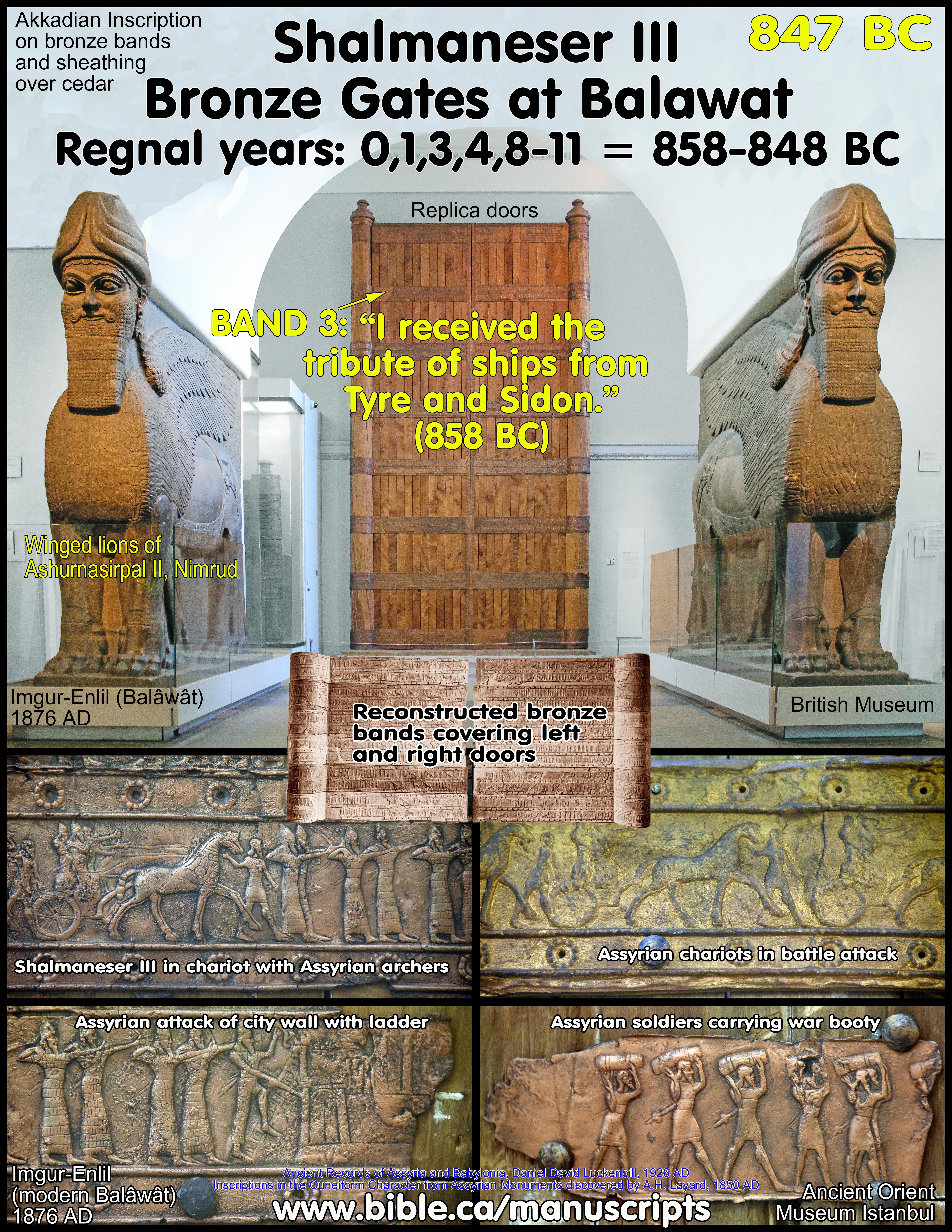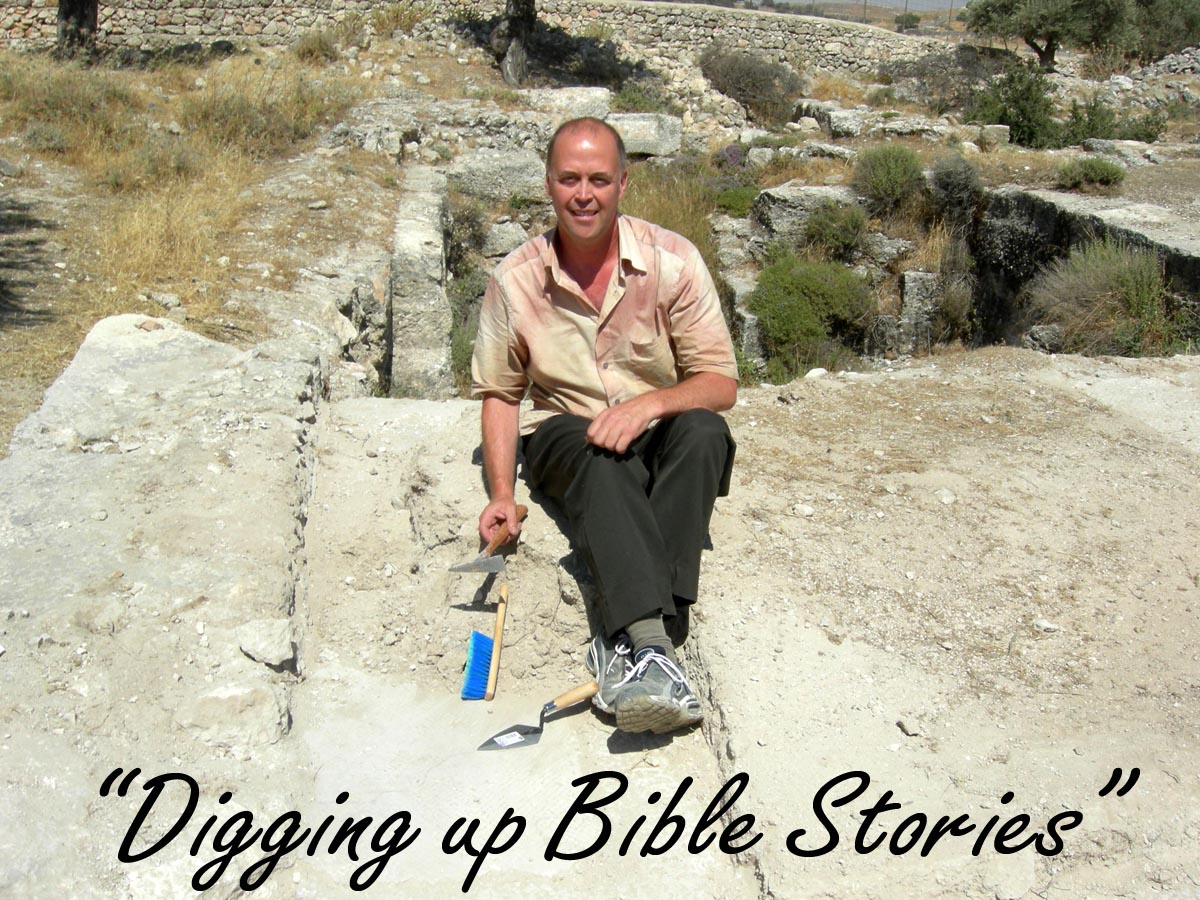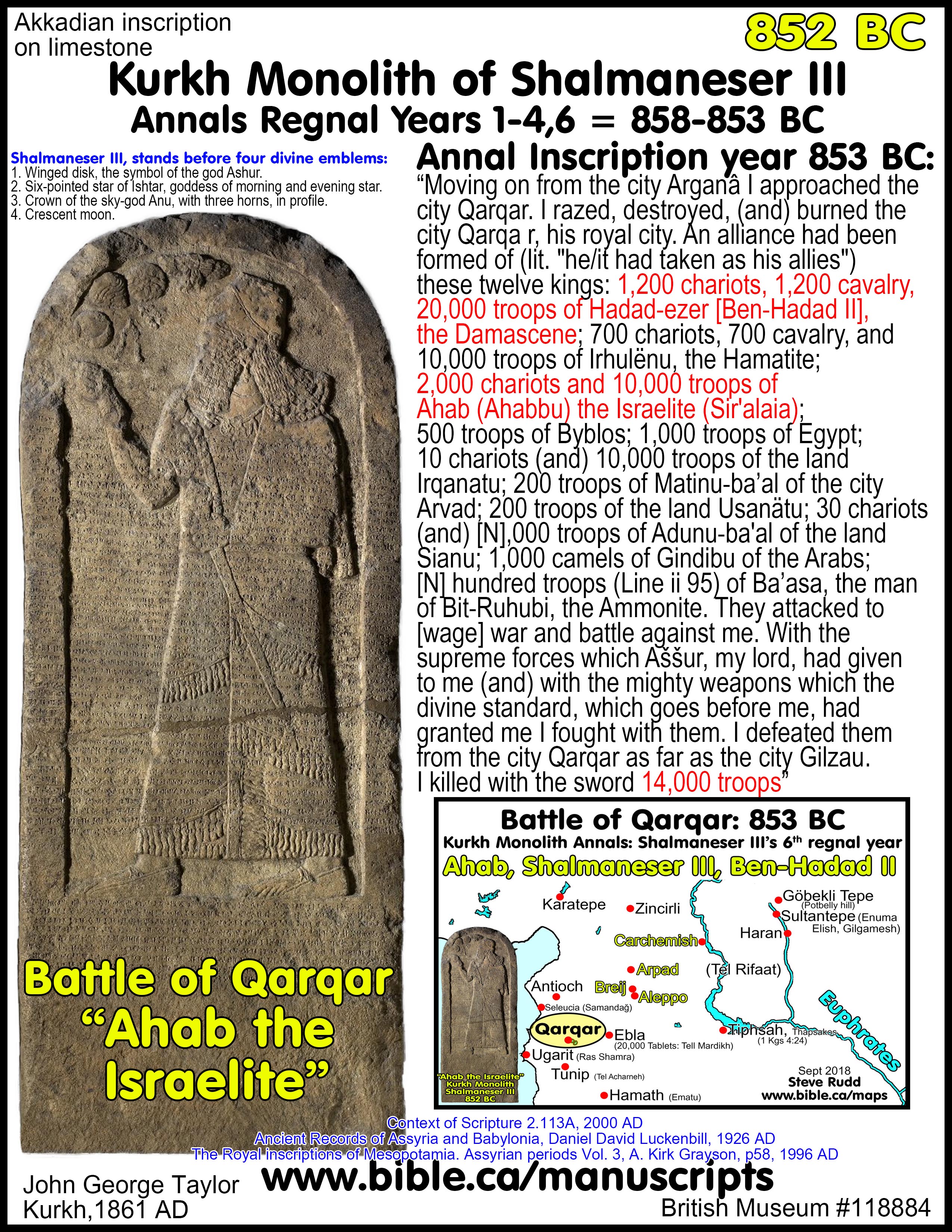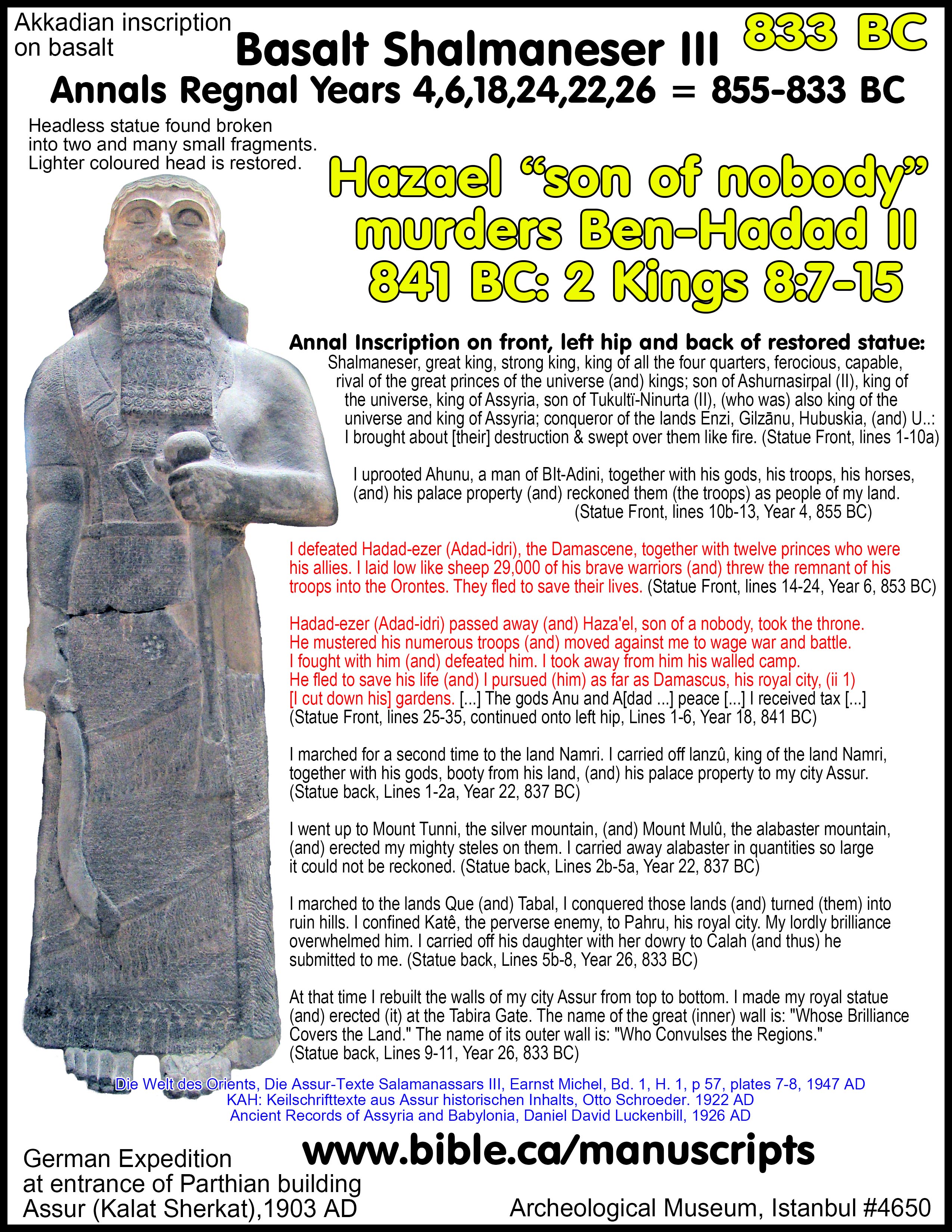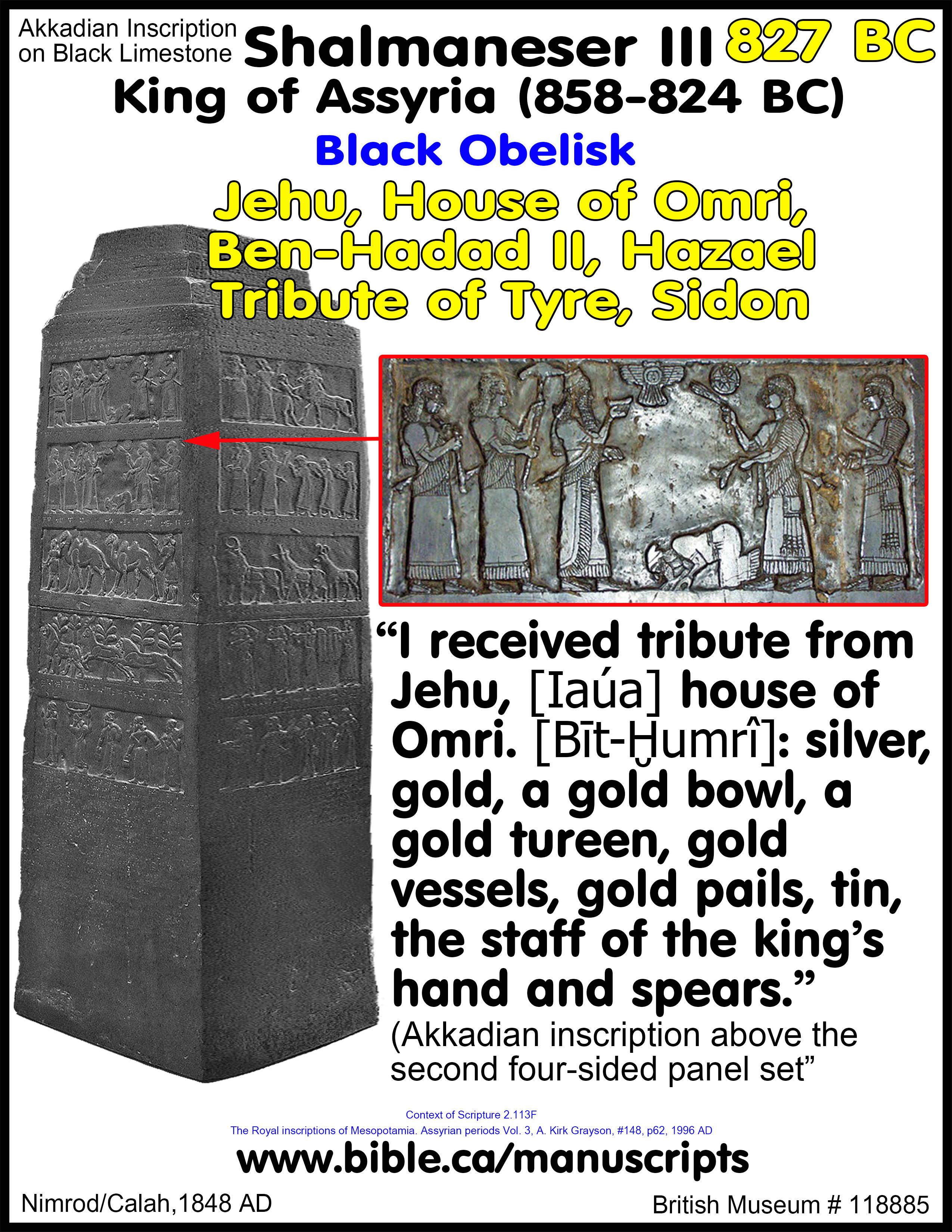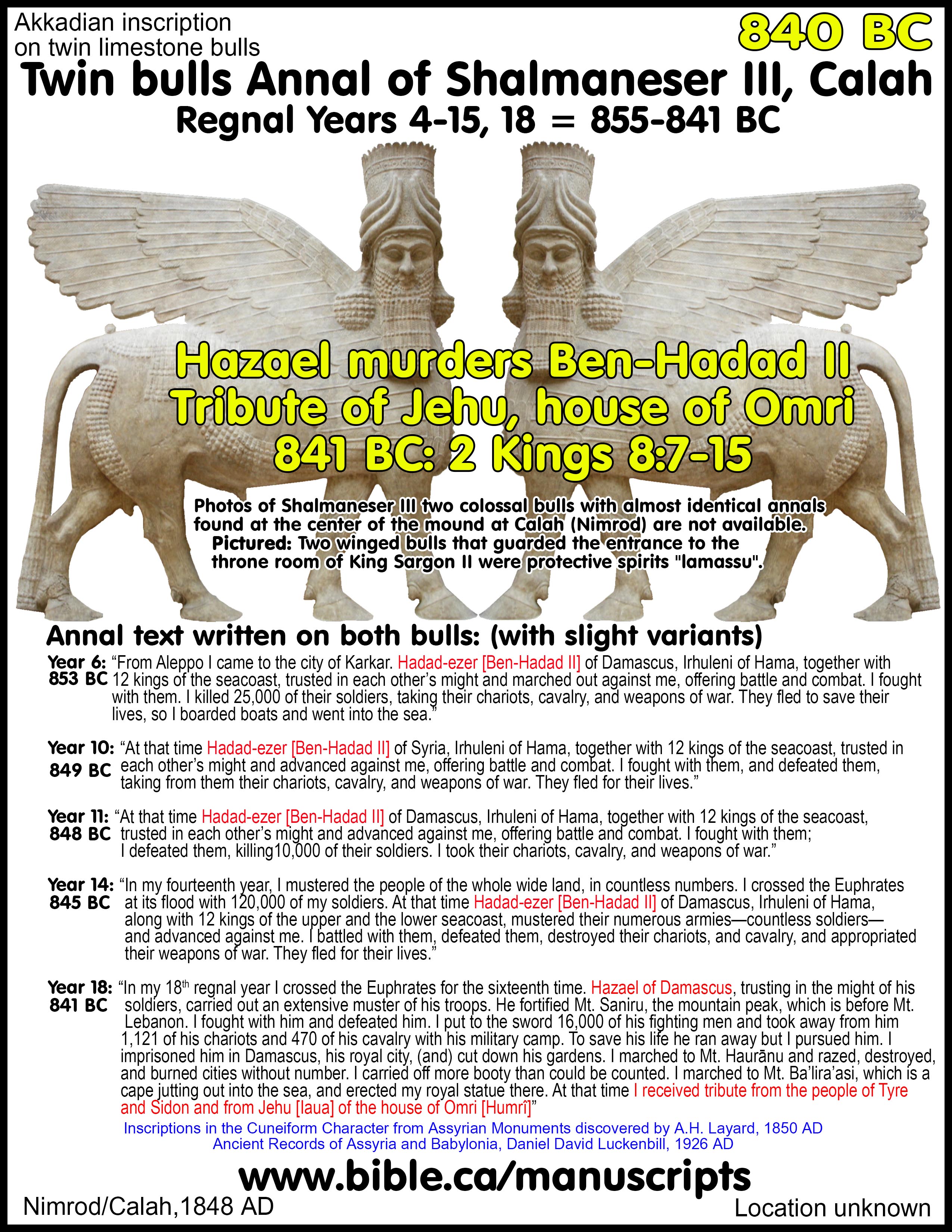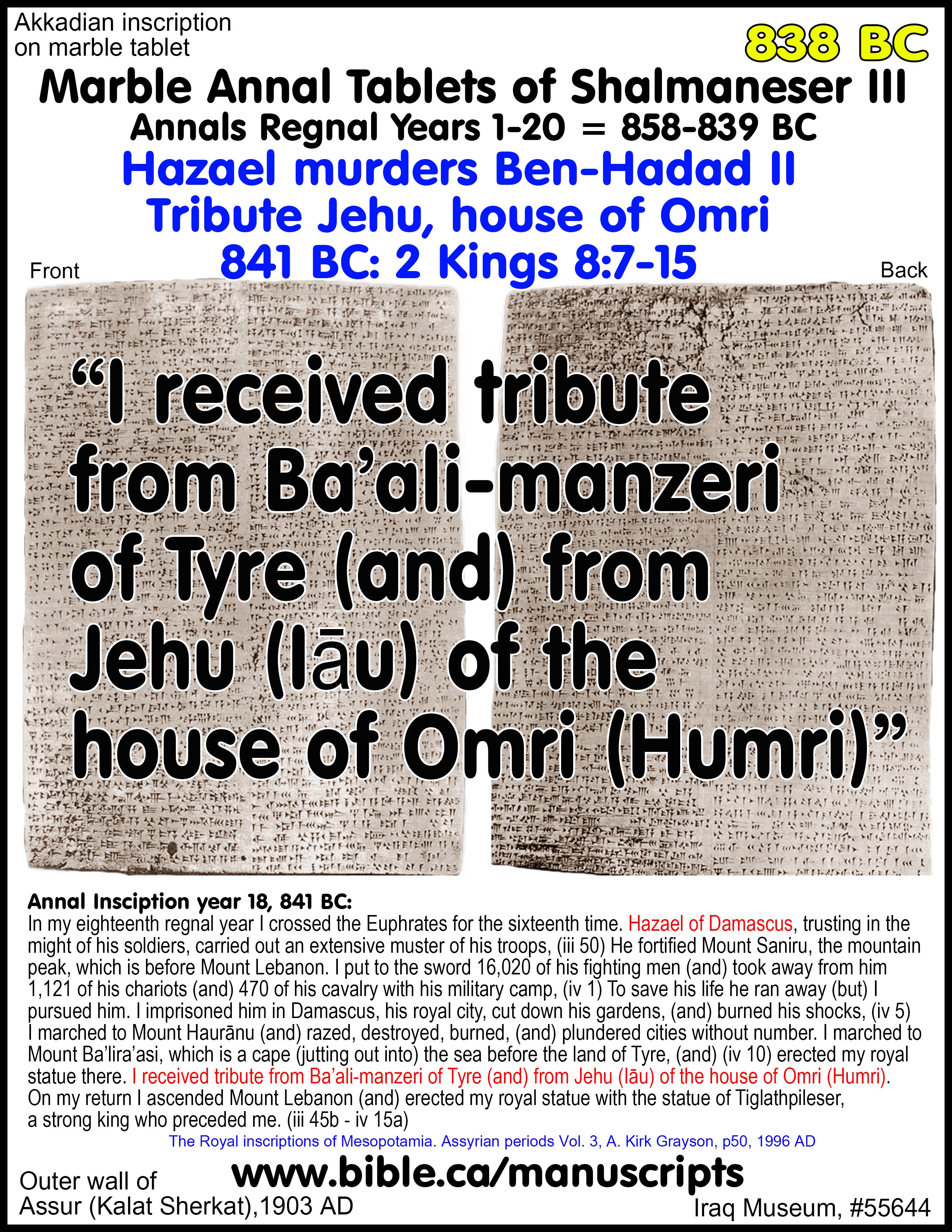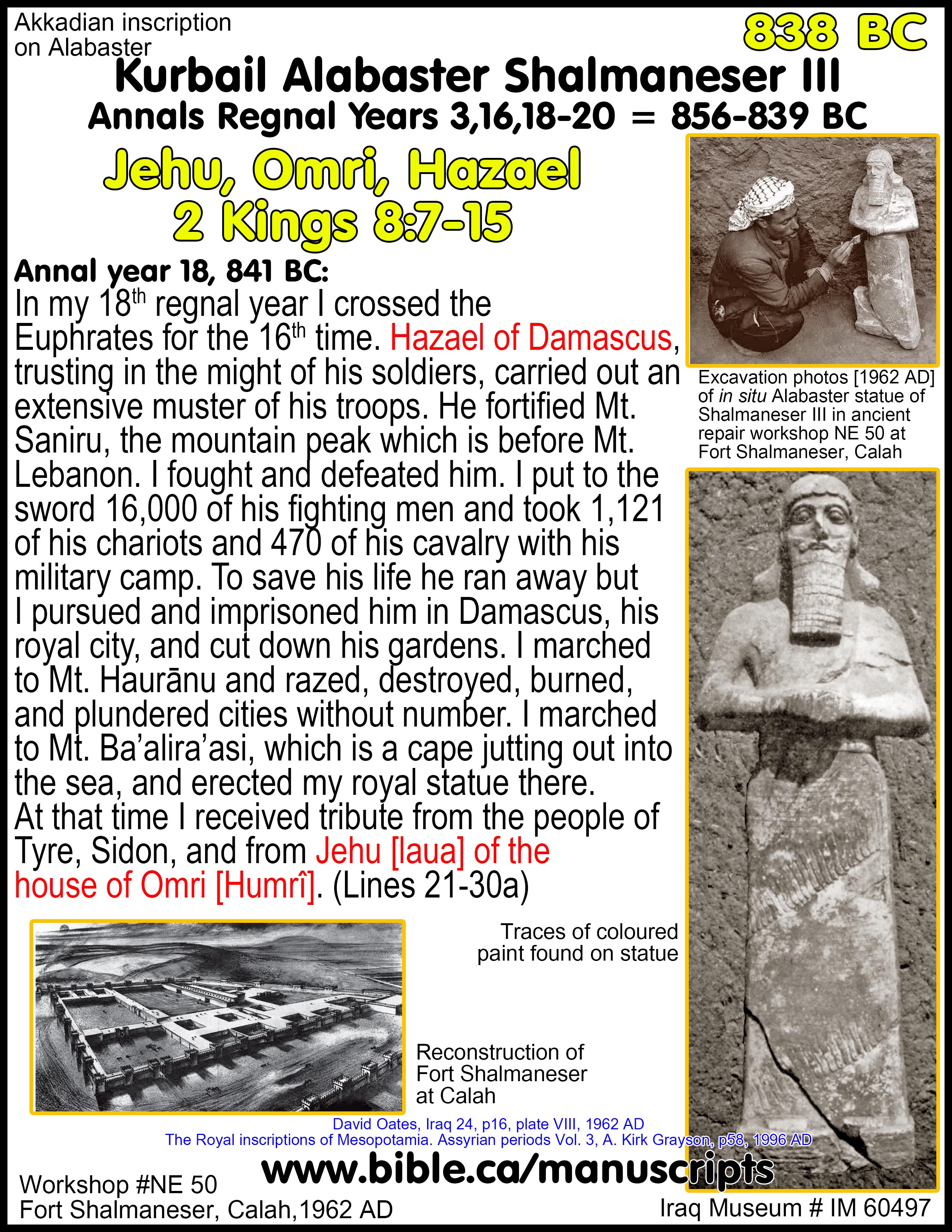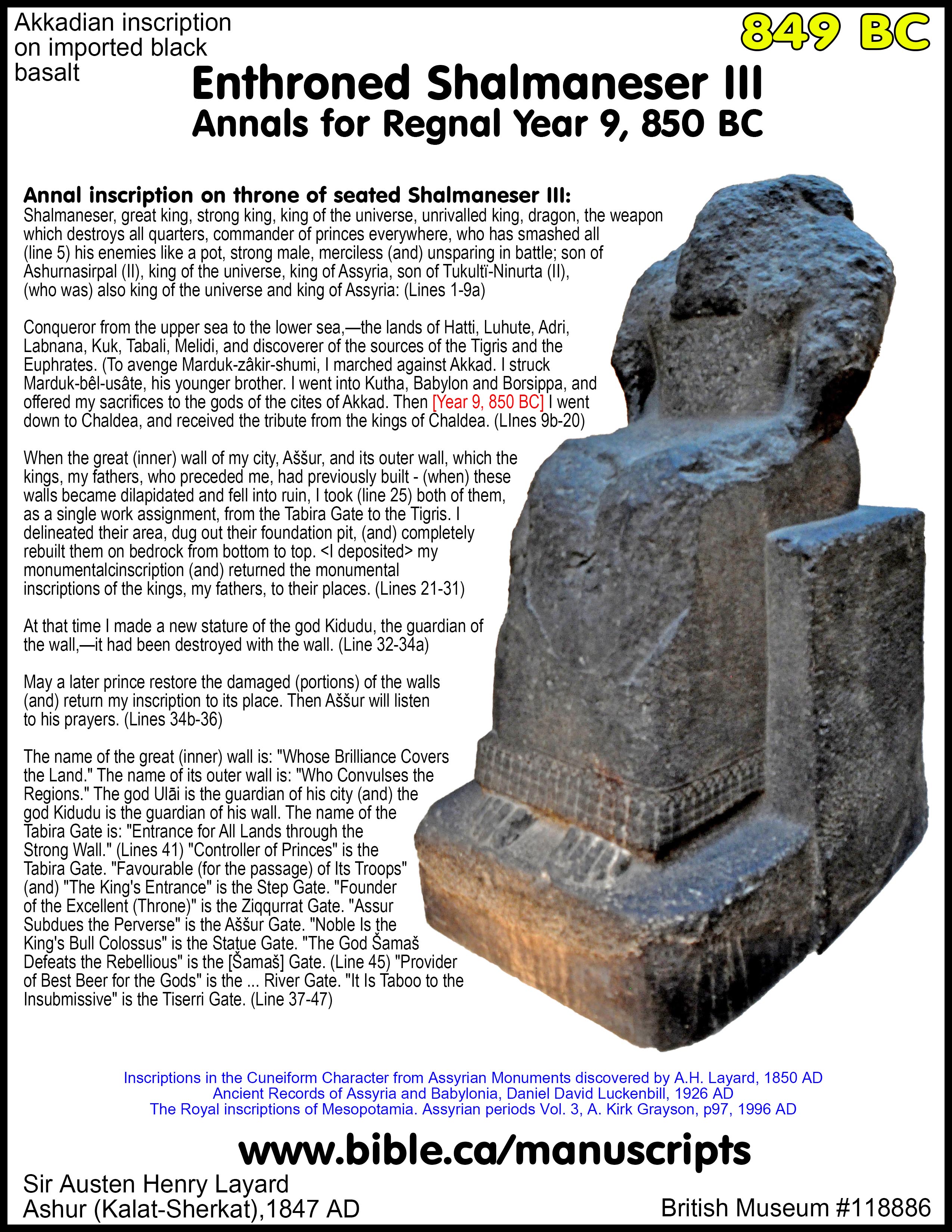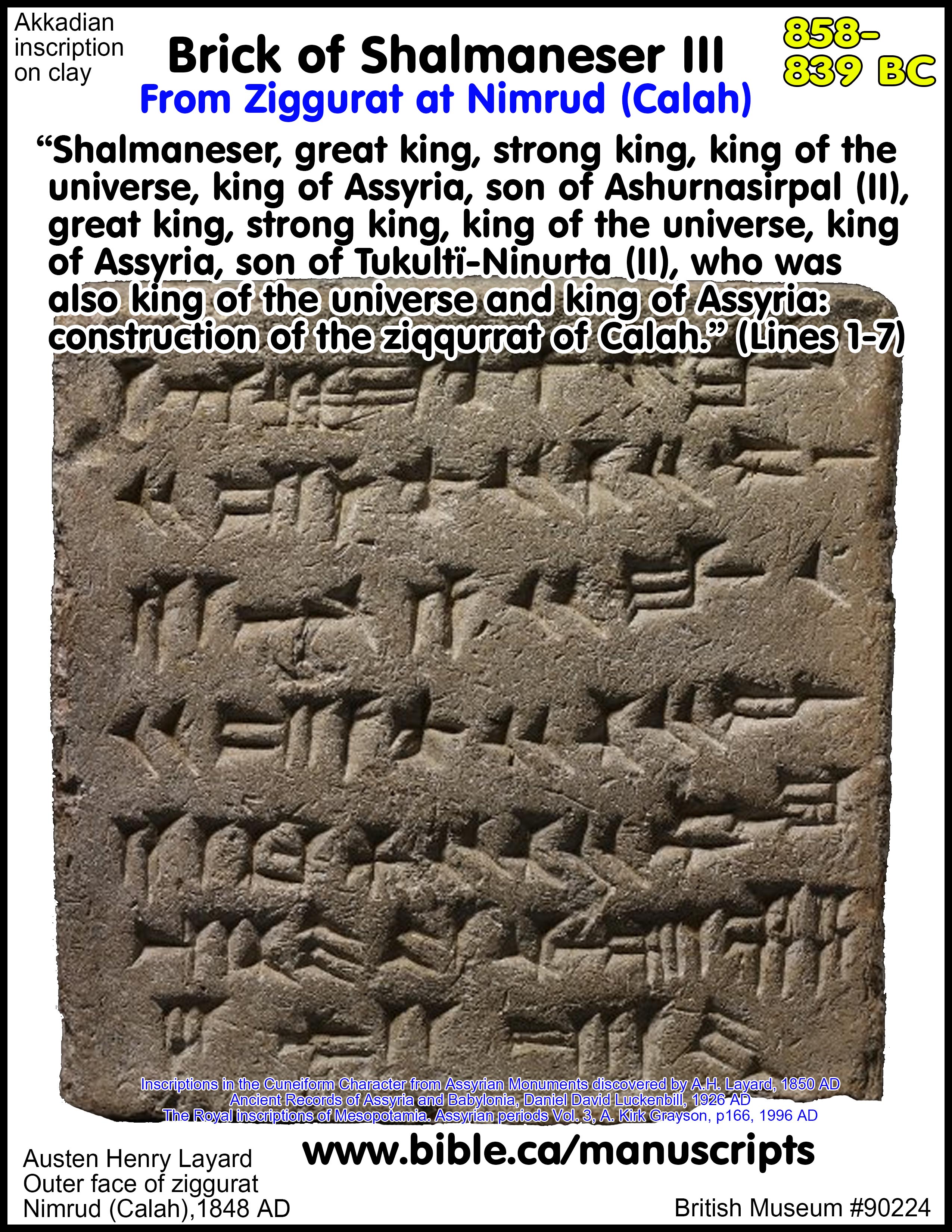Bronze Gates of Shalmaneser III from Imgur-Enlil (modern Balawat): 838 BC
Shalmaneser III, King of Assyria 855-841 BC
“Tribute of ships from Tyre and Sidon”
See also: Detailed outline on Shalmaneser III
|
Bronze Balawat Gates of Shalmaneser III |
|
|
Date of inscription |
847 BC |
|
Annal years |
858-848 BC (Regnal years: 0,1,3,4,8-11) |
|
Glyptic object |
Akkadian Inscription on bronze bands and sheathing over cedar |
|
Discovery |
Imgur-Enlil (modern Balâwât) 1876 AD |
|
Current location |
Ancient Orient Museum Istanbul (replica in British Museum) |
|
Bible names |
Tribute of Tyre and Sidon |
|
Historic events |
One of the six battles between Israel (Ahab, Jehoram and Jehu) and Assyria: It highlights the ongoing battles between Shalmaneser III of Assyria and the coalition of 12 kings under the command of Ben-Hadad II: 1. Battle of Carchemish: 849 BC 2. Battle of Hamath: 848 BC |
|
Digging up Bible stories!
“Tribute of ships from Tyre and Sidon” (Bronze Band #3, upper)
“What we read in the book, we find in the ground” |
Introduction:
1. Importance of the Bronze gates at Balawat for Bible students:
a. The cities of Tyre and Sidon are listed as giving tribute of ships to Shalmaneser III
b. Two of six wars between Shalmaneser III and Ben-Hadad II and his coalition of 12 kings which included Jehu, king of Israel:
i. 849 BC, Year 10: Battle of Carchemish
ii. 848 BC, Year 11: Battle of Hamath
2. Sources:
a. Ancient Records of Assyria and Babylonia, Daniel David Luckenbill, 1926 AD
b. Inscriptions in the Cuneiform Character from Assyrian Monuments discovered by A.H. Layard, 1850 AD
3. See Detailed outline on Shalmaneser III
I. About the Bronze Gates of Balâwât:
1. The gates were cedar with bronze sheathing and 13 horizonal bands for strength.
a. On the 13 horizontal bands were 17 inscriptions that described 13 different military campaigns.
b. On the sheathing were also inscriptions of various military campaigns.
2. “The “Bronze Gates of Balâwât,” as they are popularly known from the alleged site of their discovery (in 1876), are one of the choicest treasures of the British Museum. From the earliest to the latest days of Assyrian history we hear of gates and doors of cedar, and other woods, “whose odor is pleasant,” covered with bands of bronze, sometimes even silver and gold, and set up in the entrances to palace or temple. In the Bronze Reliefs from the Gates of Shalmaneser, edited by King, will be found collotype reproductions of the thirteen bronze bands which formed part of the decoration of the “Balâwât Gates,” and which have generally been conceded to “represent the finest example of work in bronze repoussé which has survived from so early a period,” 123 King, Bronze Reliefs from the Gates of Shalmaneser , p. 9. Not so well known are the bronzes from the gates oa a palace of Assur nâsir-pal, father of Shalmaneser [DL]. The recent remarkable discoveries of Hall and Woolley a.t Tel Obeid, near the site of the ancient Ur, will hardly compel us to modify our estimate of the Shalmaneser bronzes, but they do raise the question as to whether King’s doubts as to their source, based upon the smallness of the mound of Balâwât, are justified. The reader is referred to King’s work for a detailed description of the bronzes, as well as for a bibliography of the more important works dealing with them. Below is given King’s table of “the thirteen bands in the British Museum in the chronological order of the scenes engraved upon them,” as well as a translation of the short descriptions engraved in the field above the figures by the Assyrian artists.” (Ancient Records of Assyria and Babylonia, Daniel David Luckenbill, 1926 AD)
3. SHEATHING: “In addition to the bronze bands which were nailed across the doors and around the massive doorposts, there was a sheathing of bronze running from the top to the bottom of the free edge of each of the doors. On these edgings was engraved the so-called “Gate Inscription,” in duplicate. Only a selected few events from the first four years are recorded and the inscription closes with a detailed account of the campaigns against Babylonia, years 8 and 9. But in view of the fact that the scenes and inscriptions on the bands include the campaigns against Arnę and Ashtamaku, it is probable that the gates were not set up until after the eleventh year. The text was published in TSBA, VII, 89 f., and again by Pinches, The bronze ornaments of the palace gates of Balawat. See also Billerbeck and Deliltsch in BA, VI (Part I), and Unger, Zum Bronzetor von Balawat.” (Ancient Records of Assyria and Babylonia, Daniel David Luckenbill, 1926 AD)
4. “This text is engraved on gigantic bronze gates found at Imgur-Enlil (modern Balawat), a site not too far from Calah. The gates were made of cedar boards and decorated with a series of bronze bands, which were finely incised with inscriptions and scenes in relief. Remains of similar gates of Ashurnasirpal II were found at the same site and have been included in RIMA 2 pp. 321-23. Further discussion of Assyrian gates and doors made of bronze will be found there. Like the Ashurnasirpal gates, those of Shalmaneser are being prepared for publication by the staff of the Department of Western Asiatic Antiquities at the British Museum and discussion of the relationship between the texts and scenes must await the complete publication. As with the gates of Ashurnasirpal, the various texts found on Shalmaneser's gates consist of one long text and a number of brief epigraphs. The long text is engraved twice (two exemplars), once on each of the two bronze coverings fitted to the edges of the two leaves of the gates at the point where they meet. The brief epigraphs are engraved on the bronze bands affixed in horizontal rows on the leaves of the gates. The long text is edited here while the epigraphs appear under A.0.102.63-86. The present text must date to late in 850 BC or shortly after that year since the last military narrative is of the second Babylonian campaign in the eponymy of Bēl-bunāiia. The bands with epigraphs and pictures are two years later than this. The content of the text edited here begins with the royal name, titles, genealogy, and epithets (i 1 - ii 1). It then surveys briefly campaigns to Hatti and the Mediterranean in 858 BC (ii 2-4), Urartu in 856 BC (ii 5 - iii 2), Bit-Adini in 855 BC (iii 3-6), and concludes with a more detailed account of the two Babylonian campaigns in 851-850 BC (iv 1 - vi 7). With this the text ends abruptly. There is no description of work at Imgur-Enlil or of the installation of these gates as there was on the similar gates of Ashurnasirpal II. Nor are there any concluding formulae.” (The Royal inscriptions of Mesopotamia. Assyrian periods Vol. 3, A. Kirk Grayson, p27, 1996 AD)
5. “COMMENTARY The master text is a conflation of the two exs. (ex. 1 = BM 124667 [Rm 1047] + 128156 and ex. 2 - BM 124665 and 124666 [Rm 1046]) since there are a number of lacunae in each. Both exs. have been rather carelessly inscribed, with several errors, omissions, and inconsistent spacing of signs. The publication history of the gates is sadly erratic. The first British Museum publication, by Pinches, presented the scenes and inscriptions on elaborate plates but the appearance of these spread over twenty-two years ( 1880-1902) and this resulted in confusion over their arrangement and interpretation. The second official British Museum publication, in 1915 by King, at the instigation of Budge, still failed to do justice to these artifacts although at the time it was claimed to be a major improvement over Pinches’ work. Not all of the bronzes were included and the texts were not edited, only partially translated. In addition, King and Budge questioned the veracity of the excavator, Rassam, in giving the provenance of the bronzes as Balawat. That they really do come from Balawat has subsequently been proved (see J. Oates, 1983). The bibliography below is for all texts on the bronze gates but more specific bibliographic references to individual epigraphs are given under the relevant entries. The texts have been freshly collated for this edition with the kind permission and cooperation of the staff of the Department of Western Asiatic Antiquities at the British Museum. Preparation of this edition has benefited greatly from the use of a copy and preliminary edition prepared by Hulin and revised by Walker." (The Royal inscriptions of Mesopotamia. Assyrian periods Vol. 3, A. Kirk Grayson, p27, 1996 AD)
II. Seventeen inscriptions of the thirteen horizontal brass bands:
1. 13 Expeditions on the brass band door gates:
a. There are 13 brass bands that hold the cedar planks of the two doors in place.
b. Each band tells the story of a different expedition.
c. Most bands have an upper and lower inscription for a total of 17 inscriptions on the 13 bands.
d. We can date each expedition which allows us to date the doors themselves.
|
13 Expeditions on the brass band door gates at Imgur-Enlil (Balawat) |
|||
|
Band |
Expedition Date |
Region |
Principal Places |
|
1 |
858 BC |
Armenia |
Lake Van; Sugunia |
|
2 |
858 BC |
Armenia |
Cities of Urartu |
|
3 |
858 BC |
Phoenicia |
Tyre, Sidon; Hazazu |
|
4 |
858 BC |
Northern Syria |
Dabigu |
|
5 |
858 BC |
Northern Syria |
Unku |
|
6 |
858 BC |
Northern Syria |
Carchemish |
|
7 |
857 BC |
Armenia |
Urartu; Gilzani |
|
8 |
855 BC |
North-East Mesopotamia |
Shubru |
|
9 |
854 BC |
Syria (Hamath) |
Barge, Ada, Bar-kar |
|
10 |
853 BC |
Source of Tigris |
Kulisi |
|
11 |
851 BC |
South BabyIonia |
Bit-Dakuri |
|
12 |
849 BC |
Battle of Carchemish with Ben-Hadad II and 12 kings |
Arne |
|
13 |
848 BC |
Battle of Hamath with Ben-Hadad II and 12 kings |
Ashtamaku |
|
Ancient Records of Assyria and Babylonia, Daniel David Luckenbill, 1926 AD |
|||
2. 17 Horizontal inscriptions on the 13 bronze bands:
a. Band 1 upper: “I set up an image on the shore of Lake Van; I offered sacrifices to my gods”
b. Band 1 lower: “I captured Sugunia, the city of Arame of Armenia”
c. Band 2 upper: “Attacked [ ] of the land of Armenia”
d. Band 3 upper: “I received the tribute of ships from Tyre and Sidon.”
e. Band 3 lower: “Attacked the city of Hazazu”
f. Band 4 upper: “Attacked Dabigu, the city of Ahűni, son of Adini”
g. Band 5 upper: “Tribute from the Unkians”
h. Band 6 upper: “Tribute from Sangara of Carchemish”
i. Band 7 upper: “I captured the city of Arame, the Armenian”
j. Band 7 lower: “Tribute from Gilzani”
k. Band 8 upper: “I captured Uburne, the city of Anhiti of Shupria”
l. Band 9 upper: “I captured the city of Pargâ and Adâ, a city of Urhilęni in Hama (lower register) I captured Karkar, the city of Urhilęni in Hama”
m. Band 10 lower: “I captured and set fire to Kulisi, the royal city of Mutzuata. I entered the sources of the river, offered sacrifices to my gods, and set up my royal image”
n. Band 11 upper: “The tribute from Adini, son of Dakuri, the Chaldean”
o. Band 12 upper: “I captured Arnę, the city of Arame”
p. Band 12 lower: “I captured …agdâ, the city of Arame, son of Gusi”
q. Band 13 upper: “I captured Ashtamaku, the royal city of Irhulęni in Hamath, along with 86 cities”
III. Translation of the Bronze Gates at Imgur-Enlil (modern Balawat):
|
Date Regnal Year Nisan |
Translated text |
|
17 inscriptions of the 13 Horizontal bronze door bands:
|
1. Band 1 upper: “I set up an image on the shore of Lake Van; I offered sacrifices to my gods” 2. Band 1 lower: “I captured Sugunia, the city of Arame of Armenia” 3. Band 2 upper: “Attacked [ ] of the land of Armenia” 4. Band 3 upper: “I received the tribute of ships from Tyre and Sidon.” 5. Band 3 lower: “Attacked the city of Hazazu” 6. Band 4 upper: “Attacked Dabigu, the city of Ahűni, son of Adini” 7. Band 5 upper: “Tribute from the Unkians” 8. Band 6 upper: “Tribute from Sangara of Carchemish” 9. Band 7 upper: “I captured the city of Arame, the Armenian” 10. Band 7 lower: “Tribute from Gilzani” 11. Band 8 upper: “I captured Uburne, the city of Anhiti of Shupria” 12. Band 9 upper: “I captured the city of Pargâ and Adâ, a city of Urhilęni in Hama (lower register) I captured Karkar, the city of Urhilęni in Hama” 13. Band 10 lower: “I captured and set fire to Kulisi, the royal city of Mutzuata. I entered the sources of the river, offered sacrifices to my gods, and set up my royal image” 14. Band 11 upper: “The tribute from Adini, son of Dakuri, the Chaldean” 15. Band 12 upper: “I captured Arnę, the city of Arame” 16. Band 12 lower: “I captured …agdâ, the city of Arame, son of Gusi” 17. Band 13 upper: “I captured Ashtamaku, the royal city of Irhulęni in Hamath, along with 86 cities” |
|
Jan 858 BC Year 0 intro |
Titles and genealogy of the king; résumé of his conquests: Shalmaneser, the great and mighty king, king of the universe, king of [Assyria, son of Assur-nâsir-pal, king of the universe, king of Assyria, grandson of Tukulti-Urta, king of the universe, king of] Assyria; the powerful hero who in the four regions of the world gives no quarter, who conquers rebellion, to whose hand all the regions of the earth are entrusted, who crushes those who do not submit to Assur; the mighty flood, in whose hands Assur has set the ends of the lands. King of the regions (of earth, who is covered) with splendor, who is fearless in battle, [under the yoke of whose dominion, mighty and ruthless kings, as far as the setting sun, have bowed ....... Shalmaneser, the rightful ruler, priest of Assur, the powerful. (Bronze Sheathing: Column 1, Line 1–Column 2, line 2) |
|
858 BC, Year 0 pre-Nisan |
Year of accession: At that time, when the great lord Assur, [my lord, had uttered my name for the rulership] of the nations, and had crowned me with the exalted crown of dominion, (when) he had entrusted to my hand the sword, the scepter and the staff to rule all peoples, and I was going about, trusting in the aid of my lord Assur, the great lord, and the god who loves my priesthood, and when he had placed all lands and mountain regions, to their farthest border, under my hand;—I, Shalmaneser, the mighty king, the Sun of all peoples conquered from Lake Van and lake Urmia, to the Mediterranean,— I overwhelmed the Hittite-land to its farthest border so that it was like a mound left by the flood. I carried away 44,400 mighty soldiers from their lands and counted them with the people of my land...The splendor of my sovereignty I poured out over the Hittiteland. (Bronze Sheathing: (Column 1, Line 1–Column 2, line 2) |
|
858 BC Year 1 Nisan |
Campaigns to Hatti and the Mediterranean: On my march to the sea, I made a heroic image of my royal (self) and set it up beside the image of Anhirbe. I destroyed, devastated, and set fire to the cities along my path..... I marched to the Great Sea (Mediterranean) where I washed my weapons, offered sacrifices to my gods, and accepted the tribute from all the kings of the seacoast. I made a heroic image of my royal self, inscribed on it the mighty deeds which I had done by the shore, and set it up by the sea! (Bronze Sheathing: Column 2, Lines 3–5)
Band 3 upper: “I received the tribute of ships from Tyre and Sidon.” |
|
856 BC Year 3 |
Campaign to Urartu: From Enzite to Daiaeni, from Daiaeni to… I captured, destroyed, devastated, and set fire to Arsashkun, the royal city of Arama of Armenia. While I tarried in Arsashkun, Aramu of Armenia put his trust in the number of his troops and mustered all of his armies. He advanced against me intent on battle and combat. I defeated him; I shattered the resistance of his soldiers, striking down 3,000 of his fighters. I filled the wide plain with the blood of his soldiers. Then I took his battle equipment, his royal treasure, and his cavalry. To save his life he climbed a steep mountain. I ravaged the broad land of the Kutę like Girra I thundered over them like Adad the Storm-god from Arsashkun to Gilzani, from Cilzsni to Hubushkia. I established my harsh rule over Armenia.
I shut up Ahűni, son of Adini in his city, who since the days of my ancestor kings had been exercising haughty and forceful rulership, carrying off his grain, and cutting down his orchards. To save his life he crossed the Euphrates and took refuge in his fortress Shitamrat, a mountain peak which hangs from the sky like a cloud, located on the bank of the Euphrates. (Bronze Sheathing: Column 2, line 5–Column 3, line 5) |
|
855 BC Year 4 |
Campaign against Ahűni son of Adini: The next year I went after him. I besieged the mountain peak. My soldiers pursued them like the divine Anzu bird. I carried off 17,500 of his soldiers. I took Ahűni, together with his armies, his gods, his chariots (and) his horses for myself, and I brought (them) to my city Assur, and counted them among the people of my land. (Bronze Sheathing: Column 3, lines 5–6) |
|
851 BC Year 8 Eponymy of Shamash-bel-usur |
Campaign against rebels in Babylonia: In the eponymy of Šamaš-bēla-usur, at the time of Marduk-zākir-šumi, king of Kardunias, Marduk-bel-usäte, his brother, rebelled against him (and) they divided up the land evenly. Mardukzākir- šumi sent his messenger (with a plea) for help to Shalmaneser. Shalmaneser, the vigorous hero who is supported by the god Ninurta, took the road (and) ordered the march to the land of Akkad. I approached the city Zaban (and) offered sacrifices to the god Adad, my lord. Moving on from the city Zaban I approached the city Mę-turnat. I laid siege to the city, captured (it), slaughtered its (people), and plundered it. Moving on from the city Me-turnat I approached the city Gannanāte. Marduk-bē1-usāte, the rebel king who did not know what he was doing, came forth to wage war and battle against me. I defeated him, made an extensive massacre, (and) imprisoned him in his city. I uprooted his harvest, cut down his gardens, (and) stopped up his canals.” (Bronze Sheathing: Column 4, lines 1-5a) |
|
850 BC Year 9 |
Campaign against Babylonia: On a second campaign, in the year named after Bęl-bunâia, on the 20th of Nisanu I left Nineveh, crossed the Great and Little Zap Rivers, and came to the city of Lahiru. I stormed and captured it, killed its people, and carried off its spoil. Leaving Lahiru I approached Gannanate. Marduk-bęl-usate got away, like a fox, through a hole in the wall, and headed toward the Iasubi mountains, He made the city of Arman into his fortress there. I captured Gannanate, killed its inhabitants, and carried away its spoil. Then I climbed the mountain in pursuit of him, trapping him in Arman. I stormed and captured that city, slew its inhabitants, and carried off its spoil. I cut down Marduk-bęl-usate with the sword, and not one of his camp-followers who were with him escaped.
After Marduk-zâkir-shumi had conquered his foes, and Shalmaneser, the mighty king, had attained to all his heart’s desires, he (Shalmaneser) obeyed the command of the great lord Marduk. Shalmaneser, king of Assyria, issued the command to proceed to Babylon. He reached Kutha, the city of the warrior of the gods, the exalted Nergal, He bowed humbly in prayer at the door of the temple, offered his sacrifices, and presented his gifts. He entered Babylon, the connecting-link between heaven and earth, the abode of life. He went up to Esagila, the temple of the gods, the abode of the king of the universe. Before Enlil and the queen he made his reverent appearance and directed their step. He lavished splendid sacrifices and pure offerings upon Esagila; he offered his pure sacrifices in the shrines of the gods of Esagila and Babylon. He went to Borsippa, the city of the warrior of the gods, the exalted, the ferocious Son. He entered Ezida, the house of destiny, the house of his unchangeable law. He bowed in prayer and directed his step, reverently, into the presence of his lords Nabű and Nanâ. He provided large cattle and fat sheep which he offered up lavishly; he offered gifts to all alike in the shrines of the gods of Borsippa and Ezida; he prepared a feast for the people of Babylon and Borsippa, the protégés, the freemen of the great gods—he gave them food and wine, clothed them in brightly colored clothes, and presented them with gifts.
After the great gods had looked on Shalmaneser with favor, the mighty king, king of Assyria, and had “directed” his countenance, had accepted his self-abasement and praise, And had heard his prayer, I left Babylon, and went down to Chaldea, arriving at the city of Bakâni, the fortress of Adinu, son of Dakűri. I stormed and captured it, killing a large number of his men. I carried off their heavy booty—their cattle and their sheep. I destroyed, devastated, and set fire to that city. When I left Bakani I crossed the Euphrates with him, and approached Enradi, Adinu’s royal city. The terrible splendor of the great lord Marduk overwhelmed Adinu, so I received heavy tribute,—gold, silver, copper, lead, iron..., copper, and elephant tusks and hides. While I was there on the shore of the sea, I accepted tribute from King Iakinu of the sea-land, and from Mushallim-Marduk son of Aukani,—silver, gold, lead, copper..., and elephant tusks and hides. (Bronze Sheathing: Column 4, line 5-Column 6, line 8) |
|
849 BC Year 10 |
Battle of Carchemish with Ben-Hadad II and 12 kings at Arne Band 12 upper: “I captured Arnę, the city of Arame” Band 12 lower: “I captured …agdâ, the city of Arame, son of Gusi” |
|
848 BC Year 11 |
Battle of Hamath with Ben-Hadad II and 12 kings at Ashtamaku Band 13 upper: “I captured Ashtamaku, the royal city of Irhulęni in Hamath, along with 86 cities” |
Conclusion:
1. The bronze gates of Shalmaneser III are a stunning confirmation of the historical accuracy of the Bible:
a. It names the cities of Tyre and Sidon
2. Two of six battles between Israel and Assyria: It highlights the ongoing battles between Shalmaneser III of Assyria and the coalition of 12 kings under the command of Ben-Hadad II of Aram (Damascus) which included three Israeli kings: Ahab, Jehoram and Jehu.
a. Battle of Carchemish: 849 BC
b. Battle of Hamath: 848 BC
3. What you read in the book, you find in the ground! Find me a church to attend in my home town this Sunday!
|
9 Inscriptions of Shalmaneser III |
||
|
|
|
|
|
|
|
|
By Steve Rudd: Contact the author for comments, input or corrections.
